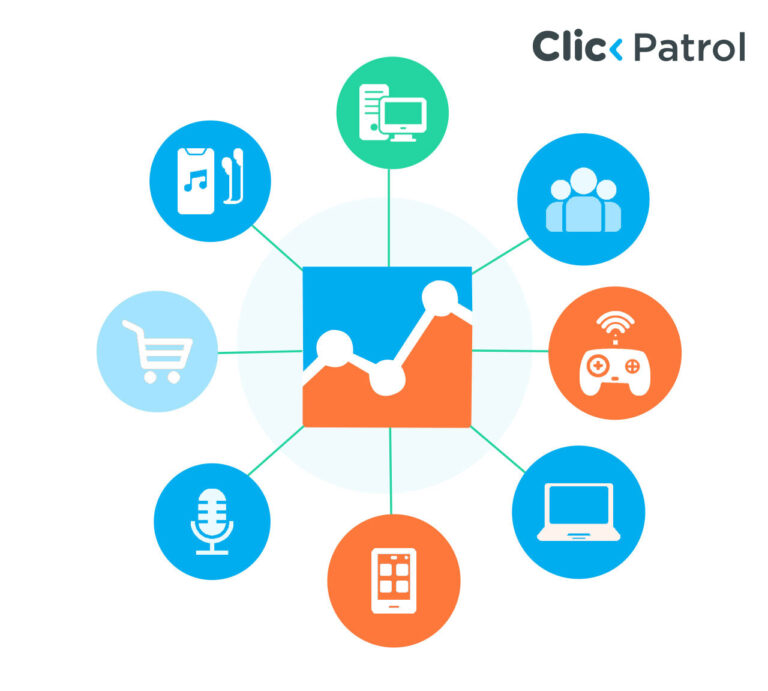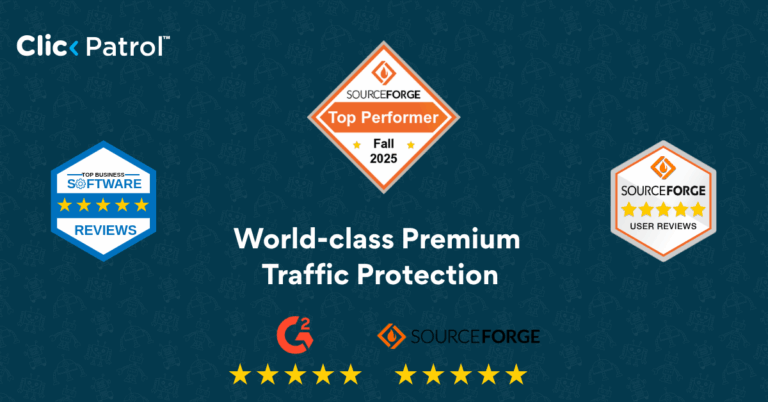
Top 7 Case Studies of Competitor Click Fraud
Abisola Tanzako | Jul 08, 2024

Competitor click fraud is a widespread problem in digital advertising, impacting businesses across various sectors. Competitors often employ competitor click fraud to drain their rivals’ advertising budgets and impede customer acquisition efforts. The numerous forms of ad fraud, including competitor click fraud, are projected to cost marketers a staggering $44 billion a year.
With adequate safeguards against invalid traffic (IVT), businesses can save money on online ad campaigns and achieve the desired outcomes. In this article, we will examine real-world case studies that illustrate the consequences of competitor click fraud. But first, we will help you understand the basics of competitor click fraud, its motivations, and how to manage it.
Understanding competitor click fraud
Competitor click fraud involves a deliberate and malicious practice where businesses click on their rivals’ online advertisements. The primary goal is to undermine a competitor’s marketing efforts by draining their advertising budgets. Competitors repeatedly click on a rival’s ads, accumulating costs over time. As a result, the targeted competitor faces challenges in maintaining a visible online presence due to wasted ad spend and skewed analytics.
This sneaky tactic can harm businesses, from reducing legitimate user traffic to impacting revenue due to fake clicks. It’s not limited to paid ads alone; it can also affect organic digital marketing efforts, such as artificially boosting competitors’ SEO rankings or leaving fake comments on social media to harm brand reputation.
The motivations for competitor click fraud
The motivations for competitor click fraud are diverse and often rooted in the cutthroat nature of modern business competition. Here’s an in-depth look at the primary drivers behind this unethical practice:
- Financial sabotage: The most direct motivation is to drain a competitor’s advertising budget. By repeatedly clicking on a rival’s ads, fraudsters aim to exhaust their competitor’s daily or monthly ad spend quickly. This can force the competitor to either increase their budget or reduce their ad presence, which can benefit the fraudster.
- Market share gain: By diminishing a competitor’s advertising effectiveness, fraudsters hope to increase their market visibility and potentially capture a larger share of customer attention and sales.
- Competitive intelligence: Some businesses use click fraud to gather intelligence on their competitors’ advertising strategies. By clicking on ads, they can see landing pages, offers, and other elements of their rivals’ campaigns.
- Cost inflation: Repeated clicks can drive up the cost-per-click for specific keywords. A fraudster with a larger budget may aim to make advertising prohibitively expensive for smaller competitors.
- Data skewing: Click fraud can distort a competitor’s marketing metrics, potentially leading them to make poor decisions based on inaccurate data. This could result in wasted resources on ineffective strategies.
- Revenge or retaliation: In some cases, click fraud is motivated by personal grudges or as retaliation for perceived wrongs in business dealings.
- Misguided marketing tactics: Some businesses mistakenly believe clicking competitors’ ads will improve their search rankings or performance.
- Industry disruption: In highly competitive industries, some players may engage in widespread click fraud to create chaos in the advertising ecosystem, hoping to benefit from the resulting confusion.
- Testing security measures: Occasionally, businesses may click on competitors’ ads to test the robustness of fraud detection systems, either out of curiosity or as preparation for more significant fraudulent activities.
- Psychological warfare: Persistent click fraud can be a form of psychological pressure intended to frustrate and demoralize competitors, potentially pushing them to abandon specific advertising channels.
These motivations often overlap and can evolve. Regardless of the motivation, competitor click fraud is unethical and usually illegal, with potential legal and reputational consequences for those who engage in it.
Impacts of competitor click fraud on your campaigns
-
Click fraud protection software: Invest in specialized tools like ClickPatrol or other click fraud protection software. These solutions automatically detect and block fraudulent clicks, saving your budget and improving campaign performance
Table of Contents
- Understanding competitor click fraud
- The motivations for competitor click fraud
- Impacts of competitor click fraud on your campaigns
- Case studies of competitor click fraud.
- 1. Motogolf.com vs. Competitor (Las Vegas Golfing Company)
- 2. Palace Plumbers (UK)
- 3. Restaurant Chain Sabotage
- 4. Criteo
- 5. Aussie Waste Disposal Specialist
- 6. Baidu vs. Qihoo 360 (2012)
- 7. Deutsche Telekom vs. Competitor
- How to manage competitor click fraud
- Fighting Click Fraud Is Important For All Businesses
- FAQs
- Wasted ad budget: Competitor click fraud consumes your ad budget by generating fake clicks. These clicks don’t lead to genuine customer engagement, resulting in wasted spending.
- Shortened ad lifespan: Excessive fraudulent clicks can exhaust your ad budget prematurely, reducing the duration your ads remain active. This limits your exposure to potential customers.
- Decreased campaign performance: Fraudulent clicks distort campaign metrics, such as click-through (CTR) and conversion rates. This misrepresentation affects your ability to assess campaign effectiveness accurately.
- Lower ROI (return on investment): When ad spending is diverted to fraudulent clicks, your actual return on investment diminishes. Legitimate conversions become more challenging to achieve, impacting overprofitability.
- Polluted analytics: Fraudulent clicks skew data on analytics platforms. Accurate insights become elusive, hindering informed decision-making. You may misallocate resources or misjudge campaign performance.
- Adversely affects long-term decisions: Relying on flawed data due to competitor click fraud can lead to suboptimal strategic choices. Misguided decisions may impact your brand’s growth and market positioning.
- Trust erosion: Advertisers lose trust on platforms where competitor click fraud occurs. Suspicion of foul play undermines confidence in ad networks, affecting long-term partnerships.
- Reputation damage: Persistent fraud can tarnish your brand’s reputation. If competitors maliciously click your ads, potential customers may perceive your business negatively, impacting future interactions.
Case studies of competitor click fraud.
1. Motogolf.com vs. Competitor (Las Vegas Golfing Company)
Motogolf.com, an online golf equipment retailer, filed a lawsuit against a competitor based in Las Vegas. The allegations centered around repeated clicks on Motogolf’s Google Ads. The competitor’s actions violated federal and state laws, leading to financial losses for Motogolf. The excessive clicks drained Motogolf’s ad budget, worth at least $5,000 in losses, and skewed valuable demographic data.
2. Palace Plumbers (UK)
Palace Plumbers, a UK-based plumbing service, relies heavily on online advertising. Eighty percent of their business comes through online ads, slowly decreasing as word-of-mouth recommendations and repeat business increase. They spend £3,000 monthly on pay-per-click (PPC) campaigns. However, they discovered many of their clicks came from competitors engaging in click fraud.
The impact was twofold: wasted ad spend, decreased ROI, and reduced visibility for genuine customers seeking plumbing services.
3. Restaurant Chain Sabotage
In a cunning sabotage, a rival chain attacked a regional restaurant chain. The competitor’s employees received explicit instructions: whenever the targeted restaurant’s location-specific ads appeared, they were to click on them relentlessly. This strategic clicking occurred primarily during peak dining hours, aiming to prevent potential customers from seeing the targeted ads.
4. Criteo
In 2016, Criteo accused competitor Steelhouse (now known as MNTM) of running a damaging counterfeit click fraud scheme. Criteo claimed that Steelhouse fraudulently took credit for user visits to retailers’ web pages by generating fake clicks on TOMS shoe retailer ads using automated bots and other methods. As a result, Criteo lost TOMS as a client.
SteelHouse, however, denied these allegations and suggested that the suit was an attempt by Criteo, a sizeable public ad tech firm, to “bully a smaller company” and prove that SteelHouse provided a more effective service.
5. Aussie Waste Disposal Specialist
In the waste disposal industry, click fraud is a growing concern. An Australian waste disposal company faced similar challenges. They implemented an anti-click fraud tool to identify irregular device IDs associated with fraudulent clicks; the company openly communicated with competitors to address the issue collectively. They aimed to reduce click fraud and protect their advertising investments by sharing insights and collaborating.
6. Baidu vs. Qihoo 360 (2012)
In China, two tech titans clashed over click fraud. Baidu, the dominant search engine, accused Qihoo 360 of manipulating ad clicks on Baidu’s advertising platform. The stakes were high as both companies vied for market supremacy. Qihoo 360, however, maintained its innocence, leading to a heated legal and public relations battle. This case underscored the need for robust fraud detection mechanisms and ethical practices in online advertising.
7. Deutsche Telekom vs. Competitor
In 2017, the German telecommunications giant Deutsche Telekom was embroiled in a high-profile case of competitor click fraud. The company, which had been investing heavily in digital advertising to promote its services, noticed unusual patterns in its ad performance metrics. After a thorough investigation, Deutsche Telekom accused a significant competitor of orchestrating a sophisticated click fraud campaign designed to deplete its advertising budget and gain an unfair market advantage.
The accused competitor had allegedly employed advanced techniques to evade detection, including IP rotation and proxy servers. This made it challenging to trace the fraudulent clicks back to their source. The fraud was not just a matter of a few errant clicks; it was a coordinated effort that had been ongoing for several months, potentially costing Deutsche Telekom millions of euros in wasted ad spend.
How to manage competitor click fraud
Managing competitor click fraud is crucial for maintaining effective ad campaigns. Here are actionable steps to combat this issue:
-
Click fraud protection software: Invest in specialized tools like ClickPatrol or other click fraud protection software. These solutions automatically detect and block fraudulent clicks, saving your budget and improving campaign performance.
- IP address exclusions: Identify the IP addresses associated with competitors engaging in click fraud. Then, exclude these addresses from seeing your ads. This prevents them from artificially inflating your click count.
- Ad schedule adjustments: Monitor competitor activity and schedule your ads to run when they are less likely to be online. By avoiding overlapping ad exposure, you reduce the chances of fraudulent clicks.
- Geographic targeting: exclude specific cities or regions where competitors operate. This prevents their employees or bots from repeatedly clicking your ads within those areas.
- Keyword monitoring: Keep an eye on the keywords your competitors are targeting. If you notice suspicious activity, adjust your keyword strategy to minimize overlap.
- Diversify advertising platforms: Using multiple ad platforms reduces your reliance on a single channel. If one platform experiences click fraud, it won’t impact your entire campaign. Diversification spreads the risk.
- Legal action for severe cases: Consider legal action when you have clear evidence of competitor click fraud. This sends a strong message and deters further fraudulent activity.
Fighting Click Fraud Is Important For All Businesses
Competitor click fraud remains an ongoing challenge in digital advertising, demanding constant vigilance and adaptability from businesses of all sizes. The case studies discussed here underline the potential financial, operational, and reputational harm caused by such malicious activities. These real-world examples reveal the diverse tactics employed by fraudulent actors and emphasize the critical importance of robust monitoring and detection systems.
These insights highlight the urgent need for a collaborative approach. Advertisers, agencies, and ad platforms must work together to develop and implement sophisticated fraud prevention strategies. It’s essential to recognize that the cases presented here represent just a fraction of a more significant issue that spans industries and affects companies regardless of size or sector.
FAQs
Q. 1 Is competitor click fraud illegal?
While the legality of competitor click fraud varies by jurisdiction, it often falls under broader laws related to technology and fraud. In some cases, wire fraud charges may apply, with potential sentences of up to 20 years. However, only some click fraudsters have faced such severe penalties. Malware kingpin Vladimir Tsastin received jail time for running a click fraud scheme that affected millions and generated over $14 million. Remember that legal recourse depends on specific circumstances and local laws.
Q:2 How common is competitor click fraud?
Competitor click fraud is frequently discussed in paid search, but it’s not as severe as some assume. Only 17% of online click fraud comes from competitors, and ad networks like Google have significant control over this issue. However, the real threat lies in bot traffic, which accounts for many fraudulent clicks. Bots mimic human behavior and can waste ad budgets, affecting website user experience. Businesses should prioritize addressing bot-related issues to safeguard their campaigns.
Q:3 What should I do if I suspect a competitor’s click fraud?
If you suspect competitor click fraud, consider these steps:
- Monitor patterns: Monitor unusual click patterns, such as sudden spikes or repetitive clicks from specific IP addresses.
- Analyze data: Use analytics tools to identify suspicious activity. Look for excessive clicks without corresponding conversions.
- Block IPs: Block suspicious IP addresses to prevent further fraudulent clicks.
- Report to ad networks: Inform the ad network (e.g., Google Ads) about your suspicions. They may investigate and take action.
- Legal action: Consult legal advice if the issue persists or causes significant harm.





